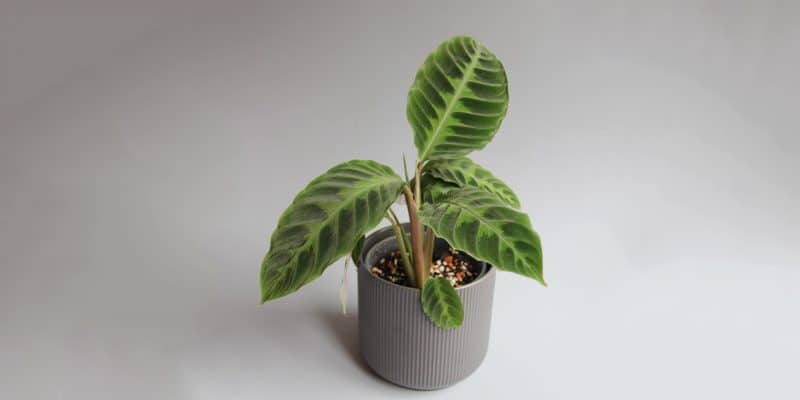Calathea warscewiczii, common name Jungle Velvet, is a bona fide star. One look at this dazzling plant, and you’ll be ready to whisk it away from the nursery and into your home faster than you can say “jungle paradise.”
Calathea warscewiczii boasts velvety, dark-green leaves boldly painted with lighter-green vein patterns and burgundy undersides, creating a visual treat in any room.
We know you’re eager to learn all about this fabulous flora, so we’ve packed this article full of essential Calathea warscewiczii care tips to ensure your plant pal thrives!
Table of Contents
Calathea Warscewiczii Plant Care Guide
History, Habitat, and Characteristics
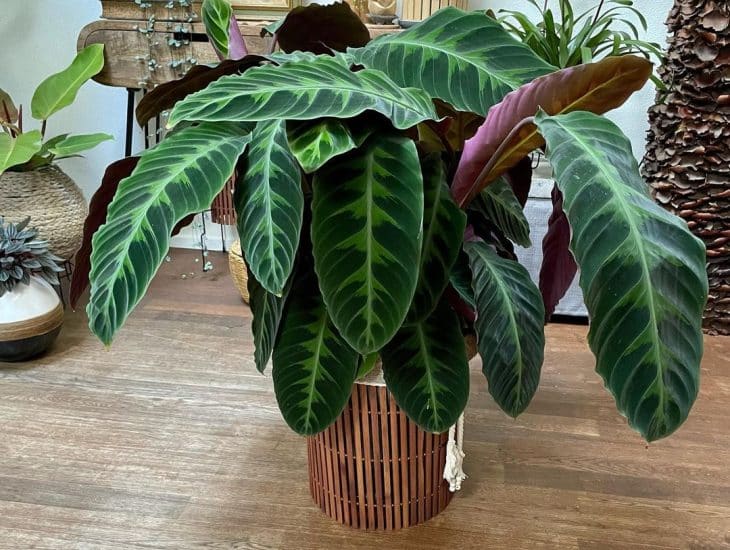
Calathea warscewiczii (Goeppertia warscewiczii) hails from the rainforests of Central and South America. In nature, this plant enjoys the rainforest lifestyle, thriving under the natural canopy created by taller trees.
One glance at the Calathea warscewiczii and you’ll notice its long, dark green, oval-shaped leaves. These leaves don’t merely dazzle with their light green fishtail pattern running down the center, but they also have a charming ruffle along the edges. The elegant dark plum color gracing the backside of the leaves is the cherry on top.
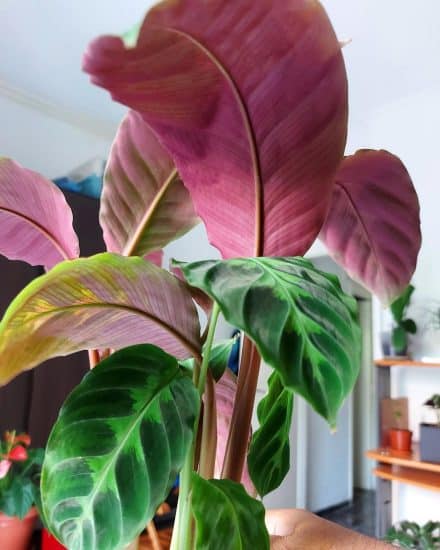
What really steals the show is the velvety texture of its leaves and stems. The fuzzy texture isn’t just a visual and tactile treat for admirers — it comes from little hairs on the leaf surface that reduce transpiration and help the plant retain humidity in hot climates.
As if its appearance wasn’t enough, the Calathea warscewiczii also boasts a totally manageable growth habit. This non-climbing, non-vining tropical plant grows in bushels, typically reaching a modest height of 2 to 4 feet.
Calathea species get a bad rap for being fussy plants, but if you manage their care properly, they’re totally worth it. That’s why, despite its reputation, calathea remains a popular houseplant the world over.
Light
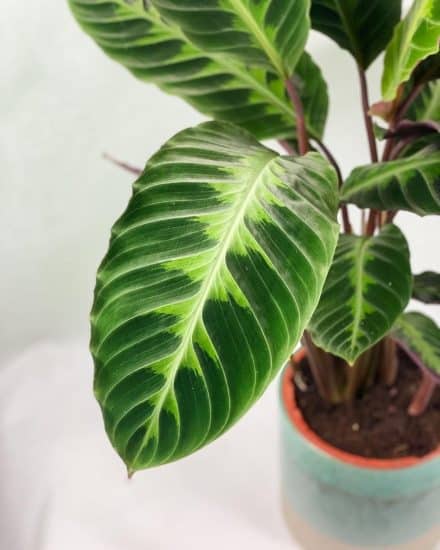
Like many tropical plants, Calathea warscewiczii thrives in medium indirect light, and it’s absolutely essential to shield it from direct sunlight. Luckily, even a room with a decent north-facing window that offers ambient indirect light can make a suitable environment.
If your Jungle Velvet calathea isn’t basking in enough light, the leaves may lose their luster, and the plant might showcase slow, leggy growth. In more extreme cases, you might notice the leaves drooping and those beautiful dark green colors and patterns fading away.
On the flip side, overexposure to light can throw your Jungle Velvet calathea into a fit of despair. Symptoms include faded, sun-bleached leaves and the appearance of tiny holes scattered throughout the foliage. Too much direct sun can cause leaves to curl or display signs of burning, like crispy, brown tips as well.
Our lighting tips:
- East- or north-facing windows are your Calathea warscewiczii’s happy place, offering just the right amount of medium indirect light.
- Got a south- or west-facing window? No problem! A sheer curtain will filter the sunlight, keeping your tropical plant safe from direct exposure.
- Rotate your calathea Jungle Velvet regularly to ensure well-rounded exposure to light and even growth.
Water
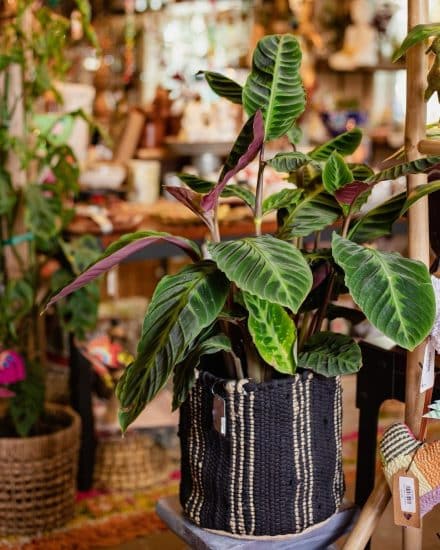
Finding the right balance for watering your jungle velvet calathea is essential for maintaining its health and vibrancy as an indoor houseplant. Calathea jungle velvet prefers moderately moist soil, but don’t overwater! Water your plant thoroughly when the top 1 inch of soil has dried out. If the soil feels moist, it’s not ready yet.
When your Calathea warscewiczii isn’t getting the hydration it needs, the plant’s leaves exhibit telltale signs like wilting, curling up, and dry, crispy edges. If it begins to look lifeless and the soil is dry, a good drink may perk it back up.
On the other hand, excessively watering your Calathea warscewiczii can lead to complications such as soggy soil and yellow leaves. Soil that remains heavy and wet without drying out and a decline in the plant’s overall health are also symptoms of overwatering. If your plant looks sad and the soil is wet, it’s most likely that you’re overwatering.
Our watering tips:
- Opt for rainwater or filtered/distilled water instead of tap water to prevent salt and mineral buildup that can harm the plant.
- Monitor the top inch of the potting mix, and water your Jungle Velvet calathea when it starts to dry out.
Temperature and Humidity
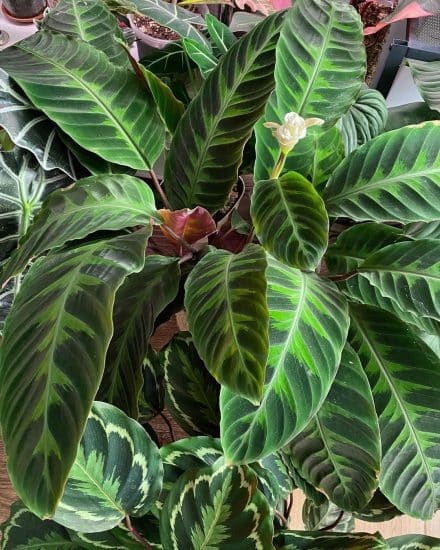
It’s essential to maintain warm temperatures above 60°F (15°C) for your calathea Jungle Velvet. Be mindful of sudden temperature changes, as they can cause leaf damage and affect your plant’s well-being. Keep your plant away from cold drafts and direct heat sources to avoid temperature-related stress.
Like many Calathea species, as well as other tropical plants, your Calathea warscewiczii loves to bask in humidity levels above 40%, and the higher, the better. While this houseplant can tolerate lower humidity levels, it might not look its best under those circumstances.
If you notice curled leaves, brown edges, or crispy tips on your Calathea warscewiczii, it may be crying out for more moisture.
On the other hand, water-soaked spots or mold could be a sign that it’s getting too much humidity. Too much moisture could lead to issues like edema, so balance is key. Maintain proper air circulation and avoid crowding your plants to prevent humidity-related problems.
To raise humidity:
- Set up a pebble tray with water under the plant to create an oasis of evaporation.
- Cluster your plants together, forming a green and humid haven for growing plants.
- Relocate your plant to a bathroom with enough bright, indirect sunlight and ventilation.
Soil and Planting
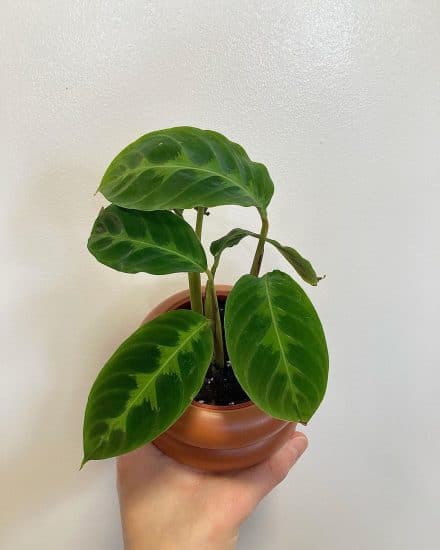
The perfect soil for Calathea warscewiczii is a well-draining potting mix rich in organic matter. Combine potting soil with cactus soil or create your own mix using materials like pumice, small bits of orchid bark, and perlite. This soil mix ensures proper aeration and moisture retention, promoting healthy and happy roots while preventing root rot.
Add compost to your soil to keep it naturally rich in nutrients and lower the pH of the soil. Calatheas like a slightly acidic soil. Another way to add acidity to soil is to add coffee grounds once a month.
Keep in mind that Calathea warscewiczii doesn’t appreciate root disturbances, so repot only when necessary. When the roots are ready to expand, choose a pot that’s slightly larger than the last, one with plenty of drainage.
If the plant appears healthy, there’s no need to remove the old soil or break up the root ball. Gently place the root ball in the new pot and fill it with the same well-draining soil mix mentioned earlier.
Fertilizing
Calathea warscewiczii will benefit from a light application of fertilizer during its growing season. Use a liquid or dry houseplant fertilizer, at half strength, from late March to October. Apply the fertilizer every other watering, ensuring your plant gets the nutrients it needs without feeling overwhelmed.
Watch out for signs of over-fertilization, such as leaf yellowing and burnt tips. If you notice these symptoms, flush the soil with water to remove excess fertilizer and adjust your fertilization schedule as needed.
Propagation
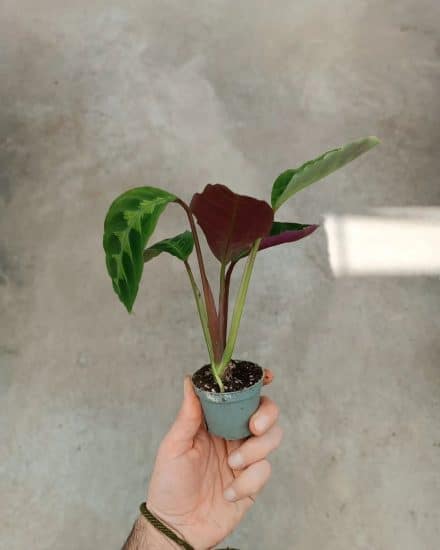
Propagating Calathea warscewiczii is accomplished through division. In this guide, we’ll walk you through the process step by step, offering tips along the way.
Propagate Calathea warscewiczii by division:
- Pick the perfect timing. The best time to propagate Calathea warscewiczii is during its active growth period, usually in early spring or summer. Make sure the new growth at the base of the mother plant has fully developed before you start dividing it.
- Gently remove the plant from the pot. Be extra cautious not to damage the roots or leaves. Lay the plant on a clean, flat surface to examine the root system and prepare for division.
- Spot the new growth clusters. This plant forms new growth clusters in a spiral pattern at its base. Take a close look and identify these clusters. They’ll become the foundation for your propagated plants.
- Divide with care. Using clean and sharp gardening shears or a knife, cautiously separate the new growth clusters from the mother plant. Make sure each division has a good-sized root system attached for the best chance of success when transplanting.
- Ready your new pots. Choose appropriately sized pots for each division (not too big!) and fill them with fresh, well-draining potting mix. Since Calathea plants prefer slightly acidic soil, consider mixing in compost, mulch, coffee grounds, or sulfur amendment.
- Plant the divisions. Set each division in its new pot, ensuring the root system is well-covered with the potting mix. Gently press the soil around the division to provide support and eliminate air pockets around the roots.
- Care for your new plants. Place your new Calathea warscewiczii divisions in a warm spot with indirect sunlight. Your new calatheas will prefer moderately moist soil, so keep the soil moist but not overly wet.
Our propagation tips:
- Patience is key: It might take a while for your new Calathea warscewiczii divisions to establish and grow. Give them time and proper care, and they’ll eventually flourish.
- Keep humidity in check: Calathea warscewiczii thrives in high humidity, so maintaining the right levels is essential for their success. Consider getting a hygrometer (cheap and so useful!) to monitor humidity in your growing space.
- Watch out for pests: Keep an eye out for any signs of Calathea warscewiczii pests or disease on your new divisions. Early detection and treatment using horticultural oil, neem oil, or insecticidal soap can make all the difference.
Common Issues
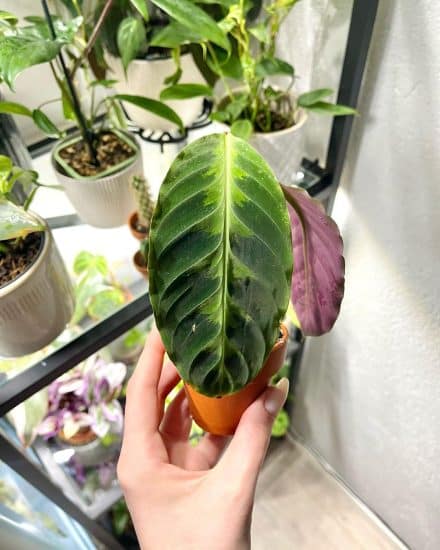
Calathea jungle velvet can face some common challenges. To care for your calathea effectively and keep it thriving, be mindful of these issues and learn how to tackle them.
Brown Leaf Tips
Noticing brown leaf tips and edges on your Calathea warscewiczii? This could be a sign that the plant is underwatered or experiencing low humidity. To handle this problem, water your plant regularly with filtered or distilled water, keeping the soil consistently moist but not waterlogged.
Another way to prevent brown leaf tips is by increasing humidity. Try placing the plant on a humidity tray, grouping plants together, or using a humidifier.
Edema
If your Calathea warscewiczii is suffering from edema, when the roots soak up more water than the leaves can handle, you’ll spot white crystals on the back of the leaves. You’ll also see yellow leaves or blistered, browning spots on the leaf surface, and possibly stems that appear spongy rather than firm. This condition is often caused by excessive humidity coupled with poor air circulation.
To aid your plant’s recovery, lower the ambient humidity around it. Prioritize proper air circulation by placing the plant in a well-ventilated area or using a small fan nearby.
Pests and Diseases
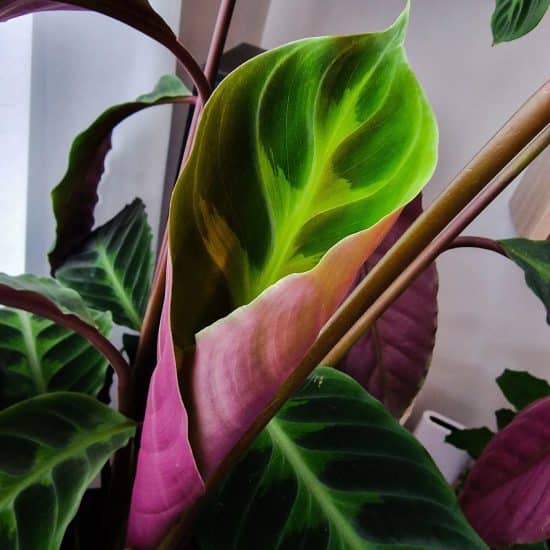
Spider Mites
These tiny critters might infest your Calathea warscewiczii, especially when humidity is low or the plant is underwatered. Spider mites are small and can be tough to spot, so keep an eye out for webbing or tiny yellow spots on the leaves. They often hide on the undersides of leaves, so be sure to check there, too!
To combat spider mites, first, give your calathea plant a thorough rinse, removing as many mites as you can. Next, grab a mixture of water and a few drops of dish soap, or use a neem oil spray, and coat your plant to eliminate any remaining mites.
Reapply the treatment every few weeks until the issue is resolved. Prevent spider mites by maintaining proper humidity levels and watering your Calathea warscewiczii consistently.
Root Rot
This common indoor plant problem often stems from overwatering or poor drainage. Signs of root rot in your Calathea warscewiczii include wilted or yellowing leaves, a foul smell, and black, mushy roots. If you’re concerned about root rot, gently pull the plant from its pot and inspect the roots.
Trim away any unhealthy roots with sterilized scissors, making sure to eliminate all affected areas. Clean the pot and discard the old potting soil to give your plant a fresh start, and replant it in fresh potting soil with perlite added for improved drainage.
To prevent root rot, make sure your Calathea warscewiczii is planted in well-draining potting soil in a pot with drainage holes. Before watering your Calathea warscewiczii again, always let the top inch of soil dry out.
Conclusion
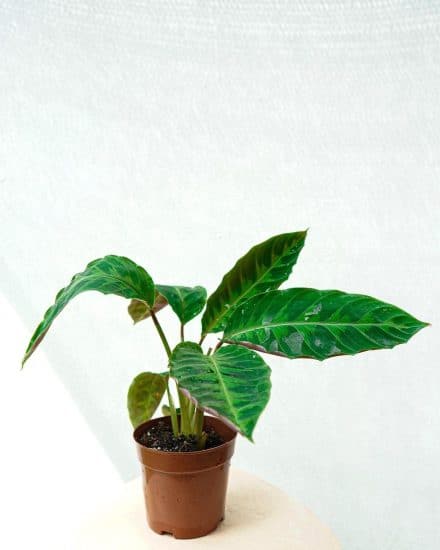
That’s it for our Calathea warscewiczii care guide!
Embracing the lush beauty of the Calathea warscewiczii can be a real joy for any plant lover. With its stunning foliage and manageable growth habit, this tropical gem is sure to become a cherished addition to your indoor garden.
Calathea warscewiczii care summary:
- Provide moderately bright, indirect light to maintain the plant’s vibrant colors and patterns.
- Water thoroughly when the top inch of soil has dried out.
- Maintain a temperature above 60°F (15°C) and avoid any cold drafts or hot spots.
- Maintain high humidity by running a humidifier or placing your plant on a pebble tray filled with water.
- Use well-draining soil and a pot with drainage holes, and fertilize lightly, only during the growing season.
We hope this comprehensive guide has provided you with all the knowledge you need to care for your Calathea warscewiczii with confidence. If you have any questions or need further assistance, don’t hesitate to reach out to us!
Happy houseplanting!
FAQ
Is Calathea warscewiczii toxic to dogs or pets?
No. These tropical beauties are nontoxic to dogs, cats, and other pets, so you can confidently display your plant without fretting over potential harm to your beloved companions.
Why is my Calathea warscewiczii drooping?
A drooping Calathea warscewiczii could be a clarion call that it’s unhappy with its current environment or care routine. Several factors might contribute to this issue. One possibility is insufficient watering — always make sure the soil is consistently moist, but be careful not to overwater.
Other reasons include inadequate humidity levels. Remember, your plant relishes levels above 40%, so it won’t appreciate sudden temperature fluctuations or exposure to drafts.
Is Calathea warscewiczii now considered Goeppertia?
Botanical classification changes have placed our beloved Calathea warscewiczii within the Goeppertia genus. This reclassification is due to ongoing research and discoveries in the botanical world (change is a natural part of life, especially for plants!).
However, the care guidelines remain the same, whether you affectionately call it Calathea warscewiczii or embrace its new identity as Goeppertia warscewiczii.

